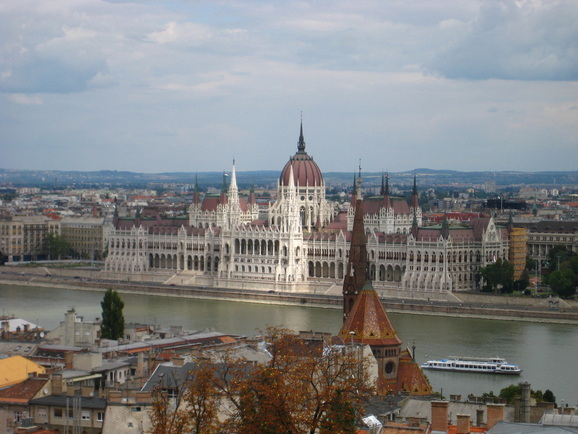
The Parliament Building of Budapest seen across the Danube from Castle Hill
The next stop on our journey was an extended layover to Budapest, taken as the most expedient way to meet our friends Tom & Amy down in Croatia. As we took a walking tour of the city, we admired the Hapsburg era architecture on Castle Hill and along the Danube River separating Buda from Pest. Budapest is full of beautiful buildings – from the Parliament building to the Opera House. They also have the oldest underground in Continental Europe (2nd in age only to London in the world), built during the glory days of the late 19th century when the country was celebrating its millennial anniversary.

A tribute to the Magyar tribes
The anniversary marks the year the 7 horse riding Magyar (Hungarian) tribes arrived in the Carpathian Basin that is present day Hungary in 896. Neda and I saw some parallels with Bulgaria here, as the Bulgars who rode into early Bulgaria were an Asiatic horse riding people as well. The Bulgars were a minority compared to the Slavs of the region (the Slavs allowed them to govern due to their ability to protect the population from the Ottoman Empire) and eventually many of their customs were assimilated with Slavic ones. In the case of Hungary, assimilation came as a result of the Mongol Horde that attacked the country in the 13th century, decimating an unbelievable half of the population. When the Mongols were finally forced out, the Hungarian crown had to repopulate their country with the peoples of surrounding areas – thus the reasons Hungarians do not appear Asian in origin.

The Szechenyi Baths
Though the Mongols were a devastating time in history for Hungary, its successive invaders would prove to be much more gracious than Bulgaria enjoyed. The inevitable invasion by the Ottoman Empire lasted only 150 years in Hungary as compared to 500 in Bulgaria. The Turks didn’t destroy the churches in the city of Budapest, but instead repurposed them as Mosques. They also left behind the culinary legacy of Hungarian Paprika and the vibrant tradition of the Turkish Baths, which built upon the fact that Buda is a hotspot of natural mineral springs along the Danube.
The Turks were forced out of Hungary by the conquering Habsburg Empire in 1686. But the mid 19th century, however, Hungary had managed to establish a dual monarchy that made Budapest a 2nd capital of the empire alongside Vienna. This stability led to unprecedented growth during which time such architectural marvels as the Parliament Building and underground line were constructed.

St. Matthias Church was preserved by the Turks, but their remnants remain in the black tower seen in the back - primarily functional when the church was used as a mosque during Ottoman rule.
All this is not to say that Hungary has had an easy history. But its beginnings have an interesting similarity to those of Bulgaria that diverge due to Bulgaria’s proximity to Turkey and its distance from Western Europe. There was no Habsburg empire to bail Bulgaria out of 500 years of oppression by the Ottoman Empire and no relief from the 50 year reign of censorship that Communism brought. The result left us wondering how Bulgaria might have looked if it had been located further north on the continent. Would it have retained more of its architecture, most of which now is just communist style concrete slop? Of course such questions are pointless as Bulgaria’s very identity is irreparably entangled with its invaders. But then again so is Hungary’s, only their invaders left behind a bit of beauty with their destruction.

Sziget was bustling!

Our pitstop in the city was lucky enough to coincide with the Sziget festival – a week long mega festival on an island in the middle of the Danube that brings in huge acts from around the world. We danced the night away with LMFAO, Beardyman, and the Killers. With over 300,000 people in attendance the event could only be described as one hot mess. But fun for a day! Lots of partying and too many langosh’s (a Hungarian specialty comprising of a circular piece of fried dough topped with garlic, cheese, and sour cream - Neda had one with chicken paprika on it pictured here) made our stomachs ready to leave Hungary as we headed down to Crikvenica) to meet up with Tom & Amy!


